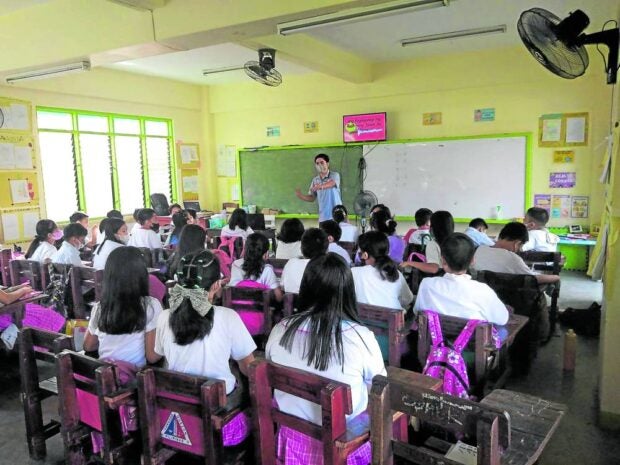Patriotism should be a learning experience, says teacher

‘INTERACTIONS’ | School teacher Lampitao said he has observed changes in how patriotism is taught in schools. (CONTRIBUTED PHOTO)
MANILA, Philippines — The country’s history of struggle against colonization and oppression has long been part of the curriculum, taught in school textbooks beginning with Grade 5 students in “Araling Panlipunan,” or social studies classes.
But how vital and relevant are these stories to generations of Filipinos since then? And how are they made to appreciate patriotism, after its spirit may have been obscured by time?
The Department of Education said in its curriculum that through its lessons, particularly about the Spanish colonial period, learners would be able to “demonstrate their insights on the importance of performing one’s duty in the advancement of national consciousness towards the formation of the Philippines as a nation.”
Felizardo Lampitao Jr. I, a public school teacher in Quezon City, said the first lesson usually introduced in history classes is Spanish colonization, the need to learn about Spanish rule, and “why we need to fight for independence.”
The discussions, he said, would involve the way of life of Filipinos, including their struggles, during that era spanning more than three centuries.
‘Power of imagination’
“The first thing we always inject there is the last part of our national anthem that we sing about — ang mamatay nang dahil sa’yo [to die for one’s country] — [which is] true patriotism. What it means to stand for and fight for liberty and our sovereignty,” Lampitao said.
In his almost 10 years of teaching, he has observed changes in how patriotism is being taught in schools, especially among the younger generation which is drawn to new technologies and social media.
To make sure that students grasp their lessons, Lampitao said he would portray the attitude of the Spanish people and the experiences of the Filipinos using different techniques, including audio-visual materials.
He would let students watch videos of Gabriela and Diego Silang, and all the other heroes who contributed to the fight for Philippine independence.
“[The kids] are drawn into online games now. So instead, why not use the power of imagination through social media, [ask them to] research, pay tribute, and internalize how important freedom is for us Filipinos?” Lampitao said.
Better content
Face-to-face classes are also a good opportunity to discuss further their lessons, he said, as children get to appreciate better the content of their textbooks.
In one such class, Lampitao said the students were amazed to learn that most Filipino surnames have Spanish origins — as a result of Governor General Narciso Claveria’s decree in 1849 assigning surnames to the population to ensure a more efficient census and tax collection.
“There are interactions between the students and they would ask me, ‘Sir, does my surname also [have a Spanish origin?]’” he said, adding that through these discussions, the students would realize the impact of Spanish rule on Filipino culture even today.
“Because when you tell the child, when you give information that is new to them, the child is really curious and would ask questions,” Lampitao said. Despite the changing times and attitudes of each generation, he said he hoped that the youth would continue to put into practice and take to heart every line and word of “Lupang Hinirang” (“Chosen Land”), the national anthem.
“What does ‘Lupang Hinirang’ really mean and what does freedom mean? At the same time, why do we celebrate Independence Day [and] how important is it?” Lampitao said.
Written by composer Julian Felipe and poet Jose Palma, the national anthem was first played during the Declaration of Independence at Emilio Aguinaldo’s home in Kawit, Cavite on June 12, 1898.
Episodes in history
Although the anthem is now part of the country’s laws and customs — in particular, Republic Act No. 8491, prescribing the flag, anthem, and other heraldic devices of the Philippines — there was a time, early during the country’s colonization by the United States, when a law was enacted prohibiting both the national flag and anthem, among other symbols.
Given these episodes in history, children must be able to develop their patriotism.
“That’s what’s important. In our last breath, our last tear, we should bear in mind that the Philippines is our country, our land, the place of our birth, and the home of our offspring that we should love,” Lampitao said.
—WITH A REPORT FROM INQUIRER RESEARCH
* * *
Source: Official Gazette ‘INTERACTIONS’ Schoolteacher Felizardo Lampitao Jr. I said he has observed changes in how patriotism is taught in schools.
RELATED STORIES
The row, rebrandings behind Independence Day
Marcos enjoins Filipinos to embody Dr. Jose Rizal’s patriotism, perseverance
Lorenzana on Day of Valor: Emulate patriotism of WWII soldiers
Disclaimer: The comments uploaded on this site do not necessarily represent or reflect the views of management and owner of Cebudailynews. We reserve the right to exclude comments that we deem to be inconsistent with our editorial standards.
